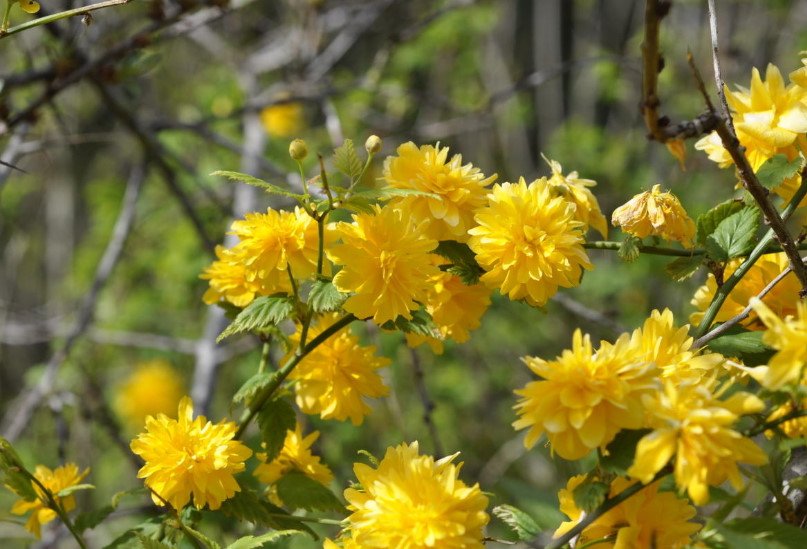
Anyway, this year the spring and the beginning of summer were very long and cold. Such a feeling, but still nature takes its toll. And judging by the fact that kerria blooms, this summer is not far off…
Kerria japonica – a beautiful deciduous shrub, the height of which can reach 2.5 m (8.2 ft). Water-loving plants, but the excess water tolerates poorly, especially closer to winter. It prefers well-fertilized organic loam and light partial shade: in the bright sun, its flowers can fade, and in the strong shade of the kerry will be bad and it can stop blooming.
In the middle zone, kerria usually blooms by the end of May, in warm years it may be a little earlier. In the same year, it is very cold, and the flowering of many shrubs has shifted greatly in time. Flowers in kerria, as in forsythia, usually appear before the foliage. It can bloom for a long time-up to three weeks, depending on the conditions and weather. During this time, the leaves usually catch up with the previously opened flowers.

In some years, in the fall, kerria can bloom again, often in the summer, individual flowers appear on the bushes.
Since the winter hardiness of this shrub leaves much to be desired, it will be better to cover the young plants for the winter. In defense of kerria, it should be said that frozen shoots quickly recover, but the plant affected by severe frosts blooms, of course, much worse. By the way, this winter all the plants and shrubs overwintered relatively well, because there was a lot of snow, and last fall it fell early and abundantly.
Boarding and care
Kerria is usually planted and replanted in early spring, before the leaves bloom, or in the second half of September, about a month and a half before the onset of persistent cold and frost. It is better to plant kerria in windless or almost windless corners of the garden: and the branches break less under the weight of flowers, and it winters in such places better.
From personal experience, Kerria still grows better on loam than on sandy soil, especially when you consider that it likes moisture. Therefore, in dry years, the bush may require additional watering.
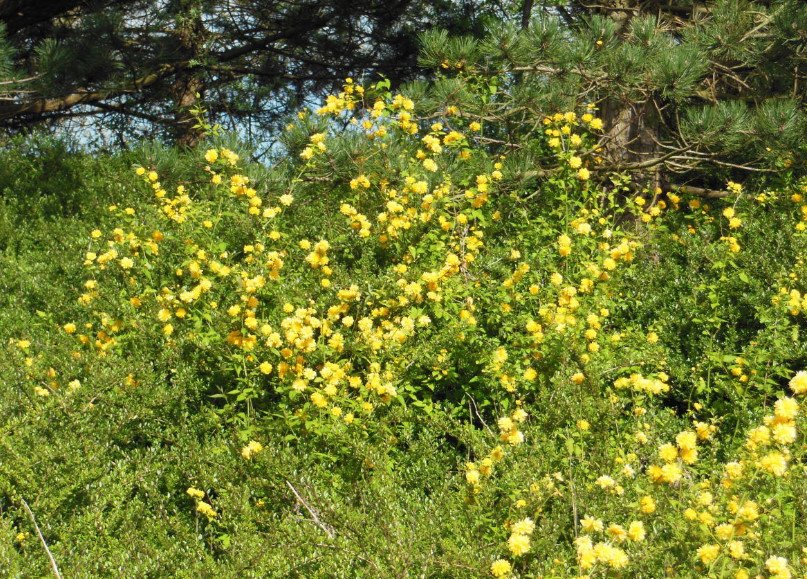
Plants can be planted from pots almost throughout the entire spring-summer growing season, with the exception of the hottest months. Young kerria bushes in the first two or three weeks will feel better in the shade.
Kerria is fed mainly organic, twice a season, preferably in late April-early May and mid-late June, but without much fanaticism. Suitable for well-rotted compost, horse manure or any other organic matter in the form of an infusion. Autumn can add a little ash, without fanaticism.
Pruning (shaping, rejuvenation and health) is very desirable. In the spring, remove branches damaged by frost or wind, and when the bush blooms, cut off the shoots from those branches that have not bloomed. This encourages kerria to re-bloom in the summer or in September.
In fact, the bushes grow quite quickly, which is why the curry can not only be cut, but even necessary. Among other things, this way you can form it in the shape that you like – in the form of a ball, a cone, or just an ordinary bush.
In winter, it is better to make a dry and well-ventilated shelter of bushes, preferably in dry weather. But here, too, without much fanaticism.
Reproduction Of Kerria
Kerria is usually propagated by layering or semi-woody cuttings. For example, consider in detail the second method of reproduction:
- cuttings cut an average of 3-4 well-developed buds;
- the lower part is straight, under the kidney, 2-3 mm (0.07-0.11 in) from the internode;
- the upper section is oblique, 2-3 mm (0.07-0.11 in) higher than the upper kidney;
- rooted cuttings should be in partial shade or shade, in a special cuttings or in the usual way – “under the jar”;
- the roots appear (depending on the weather and surrounding conditions) in about 3.5 – 4 weeks.
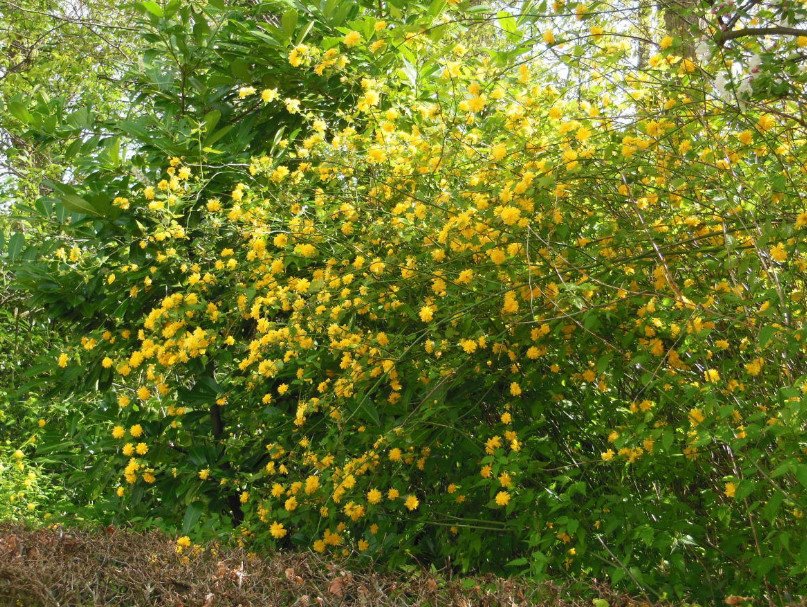
Then they should be gradually (about 4-6 days) accustomed to natural conditions, that is, to a lower humidity than in cuttings or under a jar. To do this, the cuttings must first be opened for about half an hour, each time gradually increasing this period to 2-3 or more hours. As a rule, well-rooted cuttings usually produce good growth by the end of the first season. Usually these are 1-3 new, well-developed branches.
Kerria has almost no pests, even a little hard to say why. Most likely, it is not very tasty for them. And the disease, fortunately, is rarely overcome. In this sense, kerria is a very positive plant.
In fairness, it should be said that in nature, kerria usually blooms with simple, rather than double flowers, and almost all double varieties were bred specifically by breeders.
The most famous garden varieties of Japanese kerria:
- ‘Golden Guinea’ – a variety with large (up to 6.5-7 cm/2.5-2.75 inches in diameter) flowers, simple, very bright;
- ‘Pleniflora’ – a richly flowering variety with relatively small (about 3-4 cm/1.2-1.6 in) double flowers;
- ‘Picta Variegata’ – leaves grayish-green, with a cream border, simple flowers;
- ‘Albomarginata’ – not too plush variety with attractive leaves with white edging;
- ‘Albiflora’ -interesting bright white simple flowers.
Here is a brief description of the technique of growing this plant. And now, after reading this article, everyone can choose their strategy and tactics in proportion to their experience and location of the garden. Good luck!
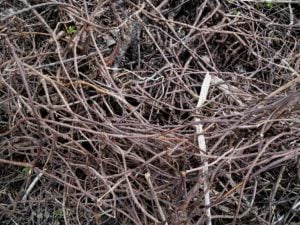


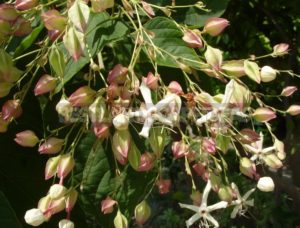
Leave a Reply